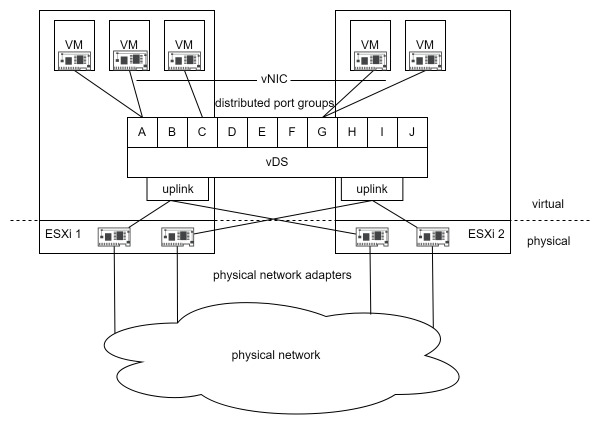In this article discuss about vSphere Distributed Switch (VDS) uses case and benefits.
The VMware vSphere Distributed Switch (VDS) provides a centralized interface to manage, monitor, and configure virtual machine access switching across the entire data center.
In vSphere, network switches are divided into two logical sections: the data plane and the management plane. Data planes implement packet switching, filtering, tagging and management planes provide control over the data plane.
vSphere Distributed Switches separate the data plane from the management plane, and the management functionality relies on vCenter Server to let you manage the networking configuration of your environment across the data center. Distributed switches have a data plane section which is called a host proxy switch, and the data plane remains locally on the hosts.
Virtual machines, virtual networks, and VMkernel services can be configured consistently using the vSphere Distributed Switch.
vSphere Distributed Switch Architecture:
Features of vSphere Distributed Switch:
- It is a feature of VMware vCenter Server.
- vSphere Distributed Switch operates on data center level. It extends networking capabilities across multiple VMware ESXi hosts within a VMWare vSphere datacenter.
- It centralizes the management of networking across multiple VMware ESXi hosts, providing a single point of control.
- As vSphere Distributed Switch are managed centrally from the VMware vCenter Server, the administrators need to define network settings once and apply them across multiple VMware ESXi hosts.
- vSphere Distributed Switch can support hundreds of hosts and thousands of virtual machines within a data center environment.
- vSphere Distributed Switch supports features like Private VLANs, Load based teaming for more precise and detailed control over individual components and in monitoring network traffic.
- vDS streamlines the deployment and management of virtual machines across multiple VMware ESXi hosts, reducing the administrative overhead.
- vSphere Distributed Switch provides features like Load-based teaming and network I/O control optimize network resources for improved performance and reliability.
- vSphere Distributed Switch is created and configured within VMware vCenter Server.
- Administrators define port groups and network settings at the VDS level, which are then applied to all VMware ESXi hosts that are a part of the vSphere Distributed Switch Configuration.
- Distributed Port Mirroring: Using port mirroring, packets seen on one switch port can be transmitted to another switch port for monitoring.
- It supports Single Root I/O Virtualization (SR-IOV)
Conclusion:
In previous article discussed about vSphere Standard Switches concept.
Hopefully this article gave you a quick Overview about vSphere Distributed Switch (VDS) concept for VMware Virtualization Environment.



One thought on “vSphere Distributed Switch (VDS)”